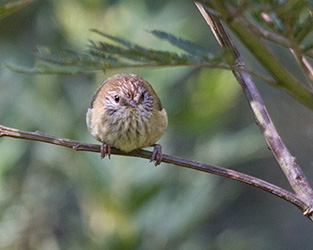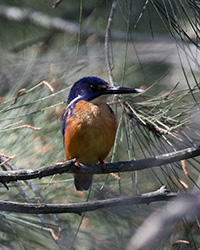Royal National Park
Tuesday, October 13, 2009:
We met at 5am for our trip to Royal National Park, a large park south of Sydney. Royal is the oldest of the Australian national parks and is the second-oldest national park in the world (after Yellowstone). As we neared the park, we stopped for breakfast. A few birds were seen from the McDonald's parking lot, but nothing new (no surprise).
Birding the Forest Path
Then it was into the park, where we started at one end of the original Forest Path. There was a lot of bird activity here. Although it was daylight now, the light was still pretty low making the first few birds hard to see clearly, and impossible to photograph well. This also led to some controversy about the first new bird, Brown Treecreeper as a White-throated Treecreeper appeared in the same tree a few minutes later, and no one clearly saw the eyebrow of the Brown Treecreeper. However, the White-throated had an obvious white throat that the first treepcreeper did not have (which prompted me to ask about the throat), so I'm pretty confident we saw both. Note that these Australian treecreepers are unrelated to the Brown Creeper and other non-Australian treecreepers. Rather, like many Australian birds, they are part of the great corvid radiation and seem to be most closely related to the bowerbirds.
In between the treecreepers, I saw my first of many Eastern Spinebills, which is a nice-looking bird. A couple of Spotted Pardalotes were high in the trees (not giving good views). An Eastern Yellow Robin put in an appearance, as did Little Corella and several types of honeyeater: Lewin's Honeyeater, Red Wattlebird, Little (Brush) Wattlebird, and Yellow-faced Honeyeater. All this was seen before we started down the trail.
 |
 |
| Little Corella | Maned Duck (Australian Wood Duck) |
We didn't get far before Susan realized the variety of calls we heard across Bola Creek were a Superb Lyrebird. Eventually, the bird was tracked down, although a number of us only got partial views of it. It made me appreciate the one I saw two days ago in the Blue Mountains. We also saw male and female Satin Bowerbird. An old bower was near the trail. It is likely a new one is nearby. Other birds seen as we headed along the trail included Brown Gerygone, Large-billed Scrubwren, Fan-tailed Cuckoo, Azure Kingfisher, and Eastern Shriketit. Some alarm calls by the Sulphur-crested Cockatoos drew our attention to a Pacific Baza. Eventually it was driven off by one of the adult cockatoos.
 |
 |
| Pacific Baza | Satin Bowerbird |
 |
 |
| Eastern Whipbird | Eastern Shriketit |
As we returned to the trailhead (having been only a short distance), we got good looks at a Striated Thornbill. A small flock of Red-browed Finches (Firetails) was in the grass, where they were briefly joined by a male Superb Fairywren. We started looking up in the trees again upon hearing a oriole, but were distracted by a Dollarbird. A couple of Noisy Friarbird were also flying about. Finally, we managed to track down the Olive-backed Oriole. What a stop this was! We then returned to the bus to head to our next location.
 |
 |
 |
| Red-browed Finch | Striated Thornbill | Dollarbird |
 |
 |
 |
| Sulphur-crested Cockatoo | Willie-wagtail | Azure Kingfisher |
Bulbuls and others
As were approached our next stop, we spooted nesting Masked Lapwings. While were were looking at them, I noticed some Galahs in the grass. We checked a couple of ponds. They gave me my life Gray Teal (which I missed yesterday) and others their life Chestnut Teal. Otherwise, we didn't have much new here, although we did see a Red-whiskered Bulbul on the way out. By then it was time for lunch.
Heathland and Cliffs
After lunch, we hunted in the heath areas for Southern Emuwren. The wind had picked up quite a bit, and although we could hear the bird, it stayed low in the “heath” and only a couple of people got reasonable looks. We continued to bird the heathlands, but wind remained a big problem. We headed for a point overlooking the Pacific Ocean. Both Superb and Variegated Fairywren were seen along the trail. As we neared the point, we saw a Humpback Whale breaching and an Australasian Gannet flying overhead. There were distant shearwaters and terns over the ocean. Unfortunately, they were distant.
A Nankeen Kestrel was perched on the rocks above, while a Rockwarbler (Origma) was active near a shrub a couple of levels down. After returning to the bus, we made several more stops in the heathland. We heard Chestnut-rumped Heathwren singing, but could not get it to come out. However, someone spotted two raptors overhead. A White-bellied Sea-Eagle was being harassed by a Black-shouldered Kite. By now, the wind was strong enough that people were wondering about whether it would affect tomorrow's pelagic.
 |
 |
 |
| Heathland | Little Wattlebird | Ocean Cliff |
 |
 |
 |
| Superb Fairywren | White-bellied Sea-Eagle | Nankeen Kestrel |
The Forest Path Again
We then tried the other end of the 10-km long Forest Path. This end of the track was also active, and we found Black-faced Monarch, Australian Golden Whistler, Leaden Flycatcher, Eastern Rosella, and Rufous Fantail, as well as several birds we had seen previously.
 |
| Australian King Parrot |
We had a little time left, so we stopped to view a waterfall. We found three Australian King-Parrots on the short trail to the base of the fall. We then returned to Sydney. After a short break, we had dinner at a nearby restaurant. On the way, Jeri had stopped to use the wireless connection at McDonald's. He had received an email to call the ship captain about tomorrow's pelagic. He did so after dinner. Apparently, they expect 15-20 foot seas outside the harbor tomorrow, so the pelagic is canceled. Jeri is trying to make alternative arrangements for tomorrow.
Trip total—96 species seen including 88 lifers (not including the two heard-only species).
Marriott Sydney Harbour, Sydney